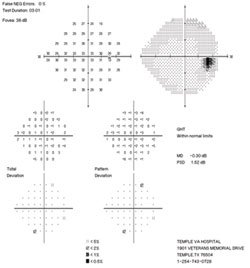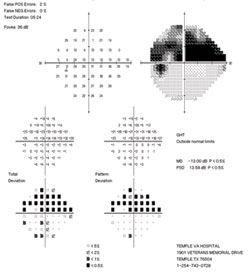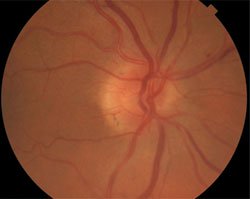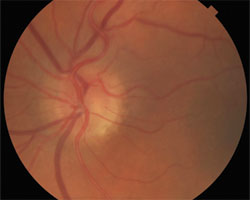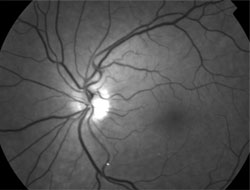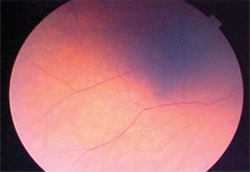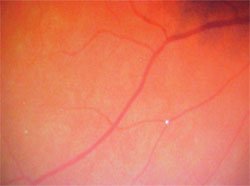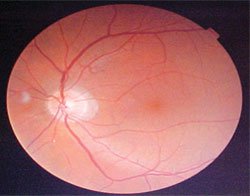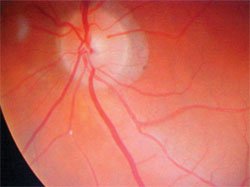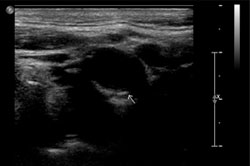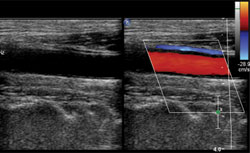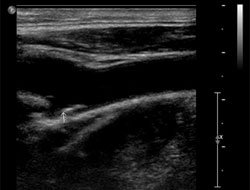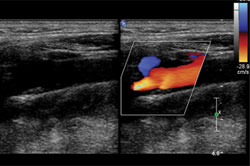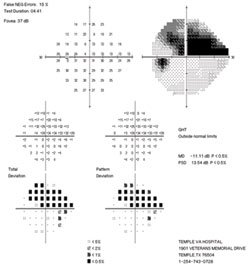Patient requesting new glasses has superior visual field loss
 Donald G. Bockin |
A 60-year-old white male came into our clinic for new glasses but complained of superior vision loss in the left eye for the last 3 years. He added that 3 years ago he had a severe coughing spell where he saw sparks, and afterward he could not see well out of the left eye. He did not seek treatment at that time, and this was his first eye examination since that episode.
The patient’s systemic medications were furosemide 20 mg daily, spironolactone 12 mg diuretic and carvedilol 6 mg tablets daily for treating congestive heart failure; lisinopril 5 mg twice daily for hypertension; and hydrocodone 5/APAP 500 mg tablets four times daily for pain.
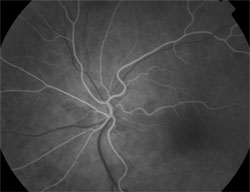  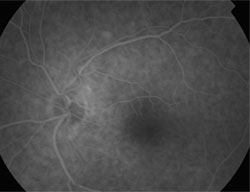 Fluorescein angiography: early phase (top photo), mid-phase (middle) shows little profusion, and late phase (bottom) shows no leakage. Images: Bockin DG |
His medical history was positive for heart valve replacement, secondary cardiomyopathy, congestive heart failure, aortic valve stenosis, mitral regurgitation, acute renal failure, sleep disturbances and sleep apnea, anemia, gastroesophageal reflux disease, depression, non-Hodgkin’s lymphoma and hepatitis C.
The patient’s best corrected visual acuity was 20/20 in each eye with a manifest refraction of -1.00 D +0.75 D x 005 OD and -0.75 D +1.50 D x 170 OS and a bifocal add of 2.25. Versions were smooth and full, and confrontation visual fields were full in the right eye, but the left eye showed a superior temporal constriction. Upon testing with a handheld Amsler grid there was a superior temporal scotoma.
|
|
|
|
The 24-2 visual field revealed a superior
altitudinal scotoma in the left eye. |
|
|
|
|
|
Examination of the optic nerves was
unremarkable. |
|
|
|
|
|
The left eye revealed two whitish areas in
the inferior perimacular area. |
|
Pupils were equal, round and reactive to light. IOP was 17 mm Hg in each eye. Examination of the anterior segment was unremarkable with only mild lenticular nuclear sclerosis that was thought to be consistent with age.
I ordered a visual field SITA standard 24-2. The examination of both optic nerves and the posterior segment of the right eye were unremarkable. The left eye revealed two whitish areas in the inferior perimacular area.

What is your diagnosis?
Differential diagnoses include: cilioretinal artery occlusion, retinitis, inflammatory disease of the choroid and retinal pigment epithelium, choroidal ischemia, retinal contusion, neoplasia, opaque subretinal precipitates, myelinated nerve fiber layer, diabetic retinopathy, retinal branch artery occlusion, retinal branch vein occlusion and retinal detachment.
|
|
|
|
|
|
|
|
|
|
Emboli are rarely bilateral, as shown here in
another patient. |
|
The central retinal artery, a branch of the ophthalmic artery, enters the eye through the optic disc and divides into multiple branches to perfuse the inner layers of the retina. A branch retinal artery occlusion (BRAO) occurs when one of these branches of the arterial supply to the retina becomes occluded.
Secondary to an embolus
Most commonly, a BRAO occurs secondary to an embolus. Emboli typically originate within vessels upstream where they dislodge and travel within the circulatory system to ultimately become lodged downstream in a vessel with a smaller lumen. The most common include cholesterol emboli from aorto-carotid atheromatous plaques, platelet-fibrin emboli from thrombotic disease and calcific emboli from cardiac valvular disease. Various other endogenous emboli as well as exogenous emboli and nonembolic causes have been reported.
The affected retina may be edematous. Ischemia of the inner layers of the retina leads to intracellular edema as a result of cellular injury and necrosis. This intracellular edema, in early occlusions, has the ophthalmoscopic appearance of grayish whitening of the superficial retina.
Funduscopic examination, in early occlusion, shows retinal whitening along the distribution of the affected artery. The site of obstruction is most often at the bifurcation of the arteries where emboli are most likely to become lodged. This occurs because bifurcation sites are associated with a narrowed lumen. In 90% of cases, BRAOs involve the temporal retinal vessels. Whether the temporal retinal vessels are affected more often or whether the nasal retinal vessels are undetected is uncertain.
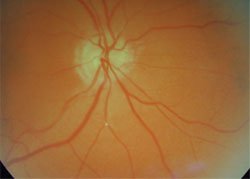 Hollenhorst plaque in another patient. |
 Calcific emboli in another patient. |
Patients with BRAO have a higher risk for morbidity and mortality secondary to cardiovascular and cerebrovascular disease. A thorough medical work-up is indicated for all of these patients, and an etiology can be identified in as many as 90%.
In the U.S., central retinal artery occlusions (CRAOs) account for 58% of acute retinal artery obstructions, BRAOs account for 38%, and cilioretinal artery occlusions account for less than 5%.
There is an increase in mortality in patients with retinal arterial emboli. Increased mortality secondary to fatal stroke has been shown in studies, but the most common cause of death in this population is cardiovascular disease.
Stroke is a devastating complication of emboli in the cerebrovascular circulation. Bruno and colleagues reported a 10-fold increase in the annual rate of stroke in patients with retinal emboli compared to controls after a follow-up period of 3.4 years.
Incidence of neovascularization rare
The incidence of neovascularization in all retinal artery obstructions is less than 5%. In BRAO, the incidence is even rarer. Neovascularization, when it does occur, is more likely in people with diabetes. Neovascular glaucoma may develop after BRAO. Ocular neovascularization after BRAO is rare. If neovascularization occurs, panretinal photocoagulation should be performed.
According to Ahuja and colleagues, race does not seem to be a factor in retinal arterial occlusive disease. Their study also suggested that whites were more likely to have identifiable carotid disease than blacks. When it comes to gender, men are 2.5 times more likely than women to have retinal emboli. This correlates with the higher rate of stroke found in men.
Patients with BRAO typically present with acute, unilateral, painless, partial vision loss, but they can be asymptomatic. Visual field defects may be central or sectoral. Partial visual field deficit may respect the horizontal midline but never the vertical midline.
|
|
|
|
|
|
|
|
|
|
Carotid Doppler ultrasonography in this
patient. A few atheromatous plaques are seen in the right carotid bulb and
bilateral proximal ICA. There is no hemodynamically significant stenosis on
either side. |
|
Risk factors include smoking, hypertension, hypercholesterolemia, diabetes, coronary artery disease or history of stroke or transient ischemic attack (TIA). Seventy-five percent of patients have hypertension or carotid occlusive disease.
Patients may give a history of temporary episodes of visual loss (amaurosis fugax) or neurologic loss (TIA).
The clinician should ask about any medical problems related to increased risk for embolus formation (e.g., endocarditis, carotid stenosis, coagulopathies, atrial fibrillation, prosthetic heart valves, poorly or uncontrolled diabetes, poorly or uncontrolled hypertension)
Emboli visible in majority of patients
Narrowed branch retinal artery, boxcarring (vascular attenuation), segmentation of the blood columns, cotton-wool spots and emboli are other possible findings. Emboli are visible in 62% of eyes with a BRAO. The emboli are usually unilateral but on rare occasions they may be bilateral.
Some of the more common emboli include: cholesterol, platelet-fibrin and calcific.
Cholesterol emboli, also known as Hollenhorst plaques, appear as iridescent, reflective, thin yellow plates. These yellow plates are white rhomboid crystals measuring 10 µm to 250 µm in length and less than 3 µm in thickness. They appear yellow on funduscopic examination because of blood showing through their translucent thinness. Digital pressure on the eye can make them turn within the vessel causing them to become more or less visible to the examiner.
If plaque is small, they do not cause occlusion of a larger arteriole artery by themselves because blood can flow around them. However, if they occur in conjunction with platelet-fibrin or if they are large, then they can obstruct arterial blood flow completely. Because their sources are most likely atheromatous plaques in the aorto-carotid system, even asymptomatic patients need a medical workup upon observation in the eye.
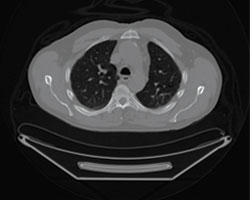 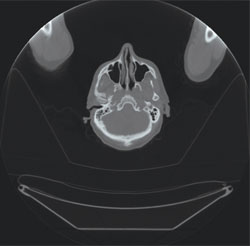 The PET/CT scans for this patient show a solitary focus of abnormal hypermetabolic activity that may correspond to an atherosclerotic inflammation vs. an adjacent subcentimeter aortocaval lymph node at the level of the right renal vein. There are no additional abnormal regions of hypermetabolic activity that indicate malignancy. The CT shows several subcentimeter lymph nodes in the mediastinum that have essentially remained stable in size when compared to the prior CT. Follow-up imaging may offer further clarification with regard to the aorotocaval finding. |
Platelet-fibrin emboli appear as whitish-gray, nonreflective plugs that are mobile. They may appear in “showers” and may pass through without causing an occlusion. They are usually associated with mural thrombus (attached to the wall) in the carotid artery or cardiac valvular structures.
Calcific emboli appear as large, yellowish-white, nonreflective plaques. They more likely are found in the larger arterioles near the optic disc and are associated with calcified cardiac valves and atheromatous plaques of the carotid artery.
Sharma and colleagues showed that attempts to categorize emboli into cholesterol, calcific or other by funduscopic examination had large intraobserver and interobserver variability. The authors recommended that systemic evaluation not be based on qualitative assessment of the type of emboli.
Epidemiology
Typically, BRAO presents in the seventh decade of life. In elderly patients, embolic disease is the most common etiology. In a study by Arruga and Sanders of 70 patients with retinal emboli, 40 were found to have cholesterol emboli, eight were found to have platelet-fibrin emboli, six with calcific emboli and one possible myxomatous embolus. (A myxoma [myxo- is new Latin from Greek muxa for mucus] is a tumor of primitive connective tissue.) These types of emboli can also be iatrogenically displaced during cardiac angiography, catheterization procedures or any interventional embolization of any branch of the carotid artery.
|
|
|
|
Follow-up visual field exam results appeared
stable. |
|
BRAO due to embolic causes is rare in patients younger than 30 years. In younger patients, other more obscure and diverse etiologies are more likely. In patients younger than 30 years with retinal arterial obstruction (RAO), associations have been noted with migraines, coagulation abnormalities, trauma, increased intraocular pressure, optic nerve drusen, oral contraceptives and other entities, which merit a more comprehensive review. Atheromatous disease is a rare cause of RAO in this age group, and routine carotid angiography for embolic cause is not recommended. Visual prognosis is similar to older patients.
Nonembolic causes
Nonembolic causes of BRAO include: thrombosis from atherosclerosis, chemotherapeutic agents and bone marrow transplants; inflammatory conditions from syphilis, Toxoplasma, retinochoroiditis, Behçet’s disease, Lyme disease, pseudotumor cerebri, Bartonella infection, HIV infection, posterior scleritis, varicella-zoster infection, multifocal retinitis with optic nerve edema or West Nile virus infection; vasospasm from migraines, cocaine abuse, possible sildenafil citrate use; coagulopathies such as sickle cell disease, Hodgkin’s disease, pregnancy, anemia, platelet and clotting factor abnormalities, protein C, protein S, antithrombin III, factor V Leiden deficiencies, oral contraceptives, homocystinuria, antiphospholipid syndrome or chelation therapy; autothrombosis from a ruptured arteriolar macroaneurysm; compression from preretinal arterial loops, vitrectomy surgery or trauma; idiopathic syndrome involving recurrent episodes of multiple branch retinal artery obstructions in otherwise healthy individuals; and association with Susac’s syndrome (microangiopathy of brain, retina and cochlea).
Fluorescein angiography shows delayed filling of the affected artery and hypofluorescence in the surrounding area. Vessels distal to the site of obstruction may show retrograde filling from surrounding perfused capillaries. Late staining of the vessel walls may be seen.
After resolution of the obstruction, flow may return to normal. However, narrowing or sclerosis of the affected artery can occur. Artery-to-artery collaterals may form in the retina and are highly suggestive of an old BRAO.
Diagnosis, management
Optical coherence tomography has been used to demonstrate structural damage of the retinal layers after retinal artery occlusion. Considering the increased rate of mortality, patients with BRAO should receive a full medical work-up with special attention to the cerebrovascular and cardiovascular system. Depending on the findings, carotid endarterectomy or anticoagulation therapy may be indicated. Laboratory work-up for coagulopathies should also be performed if no embolic source is found.
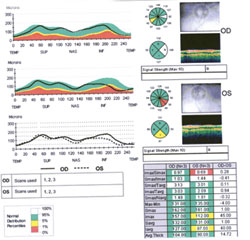 The OCT results showed nerve fiber loss in the left eye. |
To prevent stroke, most patients with BRAO are placed on some form of antiplatelet therapy. Controlling blood pressure, cholesterol and diabetes can greatly reduce the risk of atherosclerotic disease. In addition, smoking cessation can also lower the risk of stroke.
Stroke is a devastating complication of emboli in the arterial circulation, according to Doubal and colleagues. Few studies report the prospective association between retinal emboli and risk of stroke and stroke mortality. There is a 10-fold increase in the annual rate of stroke in patients with retinal emboli compared to controls after a follow-up period of 3.4 years. In addition, there is a threefold higher risk of 8-year mortality from stroke in patients with documented retinal emboli at baseline compared to patients without emboli. Also, 15% of patients with retinal emboli died within 1 year, and a mortality rate of 54% was shown within 7 years.
Recovery from branch retinal artery obstruction is usually very good without treatment; 80% to 90% of patients improve to a visual acuity of 20/40 or better. However, some degree of visual field deficit usually persists.
Patients need to be referred to an internist for complete systemic work-up and educated on health issues. They should know that this disorder may serve as a warning of more serious systemic diseases, such as cardiovascular disease or stroke, and a work-up for a systemic cause of BRAO should be performed.
Case management
This was a long standing embolus with our patient, and because of this, no emergency treatment was given. If a patient presents within 48 hours of an occlusion, it would be considered an ophthalmic emergency. Nonspecific measures are aimed at increasing retinal blood flow and dislodging the emboli. They include: lying the patient flat, applying intermittent, firm digital ocular massage for 15 minutes, administrating 500 mg of intravenous acetazolamide, inhalation of a 5% CO2/95% O2 gas mixture and anterior chamber paracentesis if indicated.
Our patient received a complete physical, including blood work, echocardiogram, bilateral carotid Doppler ultrasonography, chest X-rays and PET scan.
He returned for follow-up examination and had other medical issues and hospitalization since the last exam. He felt his vision was the same as at the last visit. There were no new visual field losses or sparks.
I ordered a repeat 24-2 visual field, which looked stable. In addition, the OCT showed nerve fiber loss in the left eye. He will have an additional follow up in 6 to 12 months.
References:
- Ahuja RM, Chaturvedi S, Eliott D, et al. Mechanisms of retinal arterial occlusive disease in African American and Caucasian patients. Stroke. 1999;30(8):1506-1509.
- Arruga J, Sanders MD. Ophthalmologic findings in 70 patients with evidence of retinal embolism. Ophthalmology. 1982;89(12):1336-1347.
- Broadway DC, Adnan T, Khaw TP. Ophthalmology Examination Techniques Questions and Answers. Woburn, MO: Butterworth Heinemann; 1999.
- Bruno A, Jones WL, Austin JK, Carter S, Qualls C. Vascular outcome in men with asymptomatic retinal cholesterol emboli. A cohort study. Ann Intern Med. 1995;122(4):249-253.
- Doubal FN, Hokke PE, Wardlaw JM. Retinal microvascular abnormalities and stroke: a systematic review. J Neurol Neurosurg Psychiatry. 2009;80(2):158-165.
- Sharma S, Pater JL, Lam M, Cruess AF. Can different types of retinal emboli be reliably differentiated from one another? An inter- and intraobserver agreement study. Can J Ophthalmol. 1998;33(3):144-148.
- Donald G. Bockin, OD, can be reached at 1174 Windy Hill, TX 76571; donbockin@gmail.com.
- Edited by Leo P. Semes, OD, a professor of optometry, University of Alabama at Birmingham and a member of the Primary Care Optometry News Editorial Board. He may be reached at (205) 934-6773; fax: (205) 934-6758; lsemes@uab.edu.

